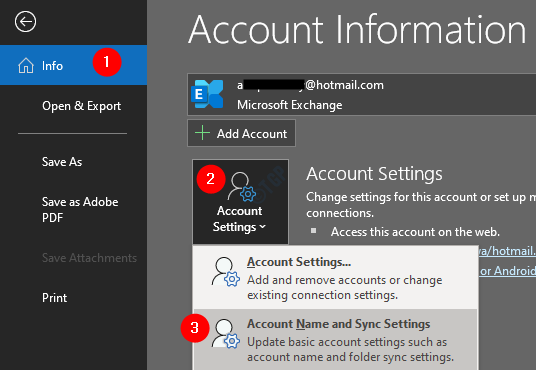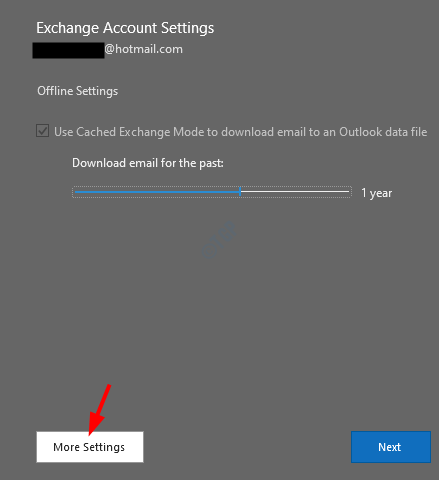Most of the Windows users have reported seeing Error Code 0x8004011D while updating their email on Outlook. The complete error message has different variants as shown below
0x8004011d Outlook not found.
Cannot register 0x8004011d Outlook
0x8004011d Outlook Access Violation
The file 0x8004011d Outlook is missing
This issue is a synchronization issue that is seen across all the Outlook versions. There are many reasons that trigger this issue. Some of the major ones are :
- Slow Internet Connectivity or Connectivity Issues.
- Corrupt System Files
- Corrupt Outlook Profile
- Virus or Malware Attack from the SD card.
If you are encountering this issue and wondering how to fix it, then stop worrying and read along. In this article, we have curated a list of fixes that can help you fix the error code 0x8004011D in outlook.
Fix 1: Enable the Cache Mode
Step 1: Open the MS Outlook Application.
Step 2: Click on File from the top menu options.

Step 3: In the appearing window, Under the Info tab, click on Account Settings.
Step 4: Click on Account and Sync Settings from the Pop-Up Context Menu.

Step 5: In the window, click on the More Settings button.

Step 6: In the Microsoft Exchange window that opens, go to the Advanced tab.
Step 7: Tick on Use Cached Exchange Mode.
Step 8: Click on Apply.
Step 9: Click on OK.

Step 10: Close the MS Outlook application. Open the application again and check if the issue still persists. If it does, check the next fix.
Fix 2: Perform an SFC Scan
Step 1: Open the Run Terminal. Use the shortcut Windows+R.
Step 2: Type cmd and hold the keys Ctrl+Shift+Enter to open the Command Prompt in Admin mode.

Step 3: If you see a User Acess window showing up asking for permissions, click on Yes.
Step 4: Type the below command and hit Enter.
sfc /scannow
Note that the scan might take some time to finish. So please be patient.
Step 4: Once, the scan finishes, Restart the system and check if the issue resolves.
Fix 3: Create a New Outlook Profile.
Step 14: Open the Run Dialog.
Step 15: Type control and press Enter.

Step 16: In the search bar located at the top right corner of the Control Panel window, enter Mail. Click on the Mail option that shows up.

Step 17: In the Mail Setup window that opens, click on the Show Profiles button.

Step 18: Click on Add.

Step 19: A window pops up, give the desired name, and press Enter.

Step 20: Make sure the newly created Profile is selected.

Step 21: Now add your account in MS Outlook.
Fix 4: Use the Registry Tweak and set up Two Exchange accounts in an Outlook instance.
In the earlier versions of MS Office ( Office 2013 or earlier), this issue is noticed when 2 Microsoft user accounts are used through the single instance of the Outlook application. If the error in your case is seen because of this issue, it can be fixed by the below registry tweak.
Step 1: Open the Run Dialog using the keys Windows+R
Step 2: Type regedit and hit Enter

Step 3: In the UAC window that opens asking for permissions, click on Yes
NOTE:
Registry editing can harm the system even with the slightest mistake. It is advised to take the backup of the registry before proceeding. To take a backup, In the Registry Editor–> Go to File –> Export –> Save your Backup file.
Step 4: In the Registry Editor window, on the search bar at the top, copy-paste the following location
HKEY_LOCAL_MACHINE\SYSTEM\CurrentControlSet\Services\MSExchangeIS\ParametersSystem
Step 5: On the right-hand side, right-click and choose New > DWORD(32-bit) Value.
Step 6: Name the newly created value as MaximumAllowedSessionsPerUser.
Step 7: Double-click on the MaximumAllowedSessionsPerUser to modify its value.
Step 8: Set the value to 2 and press OK.
Step 9: Open Run Dialog.
Step 10: Enter services.msc and press OK
Step 11: In the services window that opens, scroll down and locate Microsoft Exchange Information Store.
Step 12: Click on Microsoft Exchange Information Store and then click on Restart the service link on the left-hand side.
That’s All. Check if the issue has been resolved, if not, try the next fix.
Fix 5: Scan for Virus in Safe Mode
Some of the users have reported that this issue is caused by jutched.exe and that this virus resides in their SD cards. If you are seeing this error when you connect your SD card, then try this fix.
NOTE: If there is any important data in the SD card, please back it up before proceeding.
Step 1: Plug in the problematic SD card.
Step 2: Right-click on it and select Format.
Step 3: In the appearing window, click on Quick Format and click on Start.
NOTE: If you have time, consider opting for Full Format, to do so uncheck the box next to Quick Format as shown below
Step 4: Once the formatting is completed. restart your system.
Step 5: The moment you see the manufacturer’s logo, start pressing the F8 key. You need to be really quick.
Step 6: This opens up, the Advanced Boot Options window as shown below. Choose Troubleshoot
Step 6: Now, click on Advanced Options
Step 7: Click on Startup Settings.
Step 8: Click on the Restart button.
Step 9: Press the 5 key from your keyboard and hit Enter.
Step 10: Once your system boots in Safe Mode, click on the Microsoft Safety Scanner Download link
Step 11: Download the appropriate version.
Step 12: Double-click on the .exe file to run the application.
Step 13: Follow the onscreen instruction and complete the Scan.
Step 14: It is important to finish the scan. So, wait till you see the success message.
Step 15: Restart the system. Check if the error has been resolved.
That’s All.
We hope you have found this article informative.
Kindly comment and let us know the fix that helped you solve the issue.
Also, let us know if you run into any issues. We will be glad to assist.